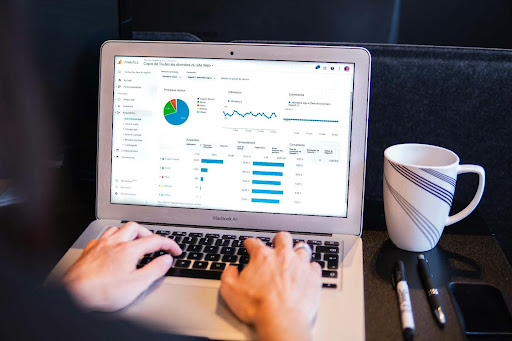In the competitive landscape of sales, one often hears the phrase “sales velocity” – a crucial metric that measures how quickly a business can convert leads into revenue. It stands at the core of a successful sales strategy, encapsulating important factors that determine a company’s financial health. Each factor influences the overall sales performance of an organization, and understanding them is critical for any sales leader aiming to boost efficiency and profitability. Below, we delve into the aspects that make up this vital metric, guiding you through ways to maximize your sales potential. Keep reading to explore the essentials of this dynamic concept.
Understanding the Four Pillars of Sales Velocity
Alt text: Person using laptop learning different components of sales velocity
Sales velocity is comprised of four primary components: deal size, conversion rate, number of opportunities, and response time. These elements work together to give businesses a clear picture of their sales processes’ effectiveness. Not only is it a measure of how quick sales are being made but also of the value and frequency of those sales.
Deal size refers to the average size of each sale, affecting the overall revenue. A larger deal size can lead to higher sales velocity, provided other factors remain constant. Conversion rates indicate the percentage of leads that turn into actual sales, a direct reflection of the effectiveness of the sales team and strategy. The number of opportunities encompasses the scale of potential sales in the pipeline, offering insight into market demand and sales efforts.
Lastly, response time measures the speed at which sales teams engage with leads. The strategic enhancement of these pillars is key, and leveraging the components of sales velocity can carve a facilitated path to boosting sales performance. It’s not about focusing on a single pillar but harmonizing all four to accelerate the sales momentum.
The Critical Role of Deal Size in Accelerating Sales
The average size of each closed deal has a profound impact on a business’s bottom line. When sales teams prioritize larger deals or upsell to existing customers, they can increase the average deal size and thereby enhance the company’s sales velocity. Implementing strategies such as value-based selling or bundling products can contribute to this goal.
Moreover, sales training focused on negotiating higher-value contracts can empower sales representatives to maximize deal size without compromising the closing rates. However, it’s essential to find a balance, as overly aggressive tactics might deter potential customers or lead to a longer sales cycle.
Lead Conversion Rates: Optimizing the Sales Funnel
Alt text: Business professional discussing components of sales velocity with colleagues
Conversion rates serve as a critical indicator of how effective a sales funnel is. It reflects the proportion of leads that become paying customers, making it a central focus for optimizing sales velocity. High conversion rates typically suggest that a company’s sales and marketing strategies are resonating well with the target audience.
To improve this metric, companies must enhance the quality of the leads they attract. This often involves refining marketing strategies and aligning sales and marketing teams to ensure they target the right audience with a tailored proposition. Similarly, nurturing leads with personalized content and follow-ups can contribute to higher conversion rates.
The Importance of Sales Response Time to Velocity
When it comes to increasing sales velocity, every minute counts. The amount of time it takes a sales representative to respond to a lead after initial contact can make or break a deal. A swift response indicates to potential customers that their business is valued and can set the tone for the entire sales journey.
Studies have shown that leads are significantly more likely to engage with a business if they receive prompt contact after their initial inquiry. Sales teams that are quick to engage are often seen as more attentive and responsive, traits that can distinguish a company in a crowded marketplace. This responsiveness can dramatically reduce the sales cycle duration, thereby increasing sales velocity.
Implementing practices such as sales automation and real-time alerts can facilitate quicker response times. Empowering sales teams with mobile technology and effective communication tools ensures they can connect with leads regardless of their location or time constraints.
Altogether, sales velocity is a multifaceted metric that requires balancing multiple elements to achieve optimal results. Overall, by prioritizing larger deal sizes, enhancing conversion rates, responding promptly to leads, and streamlining sales processes, businesses can increase their sales momentum, ultimately driving revenue and growth.
Keep an eye for more latest news & updates on Forbes Zine!




